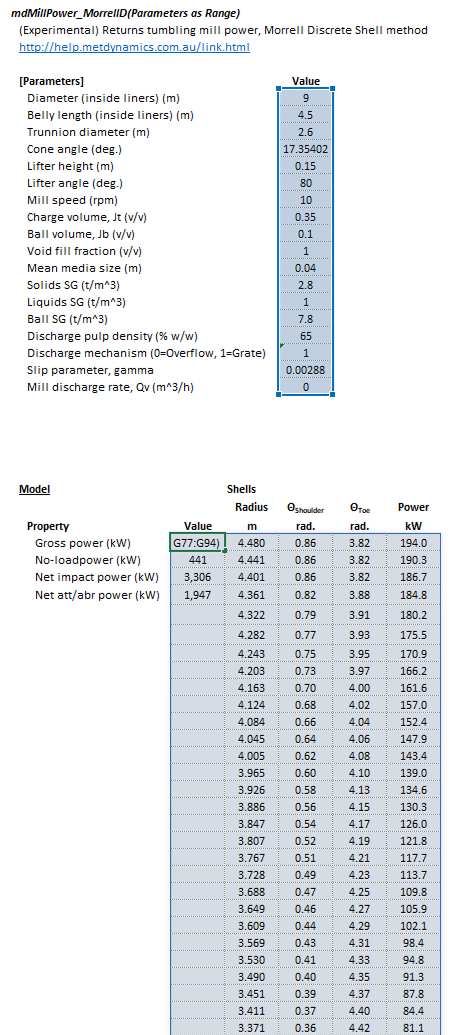Description
This article describes the Morrell Discrete Shell (Morrell D) method for estimating the power draw of a tumbling mill.[1]
The Morrel D model adopts a more sophisticated treatment of charge dynamics than the Morrell Continuum method:
- The total charge is subdivided into discrete layers, or shells, whose size and position may individually vary due to grinding media size, mill speed, lift bar geometry and other conditions.
- The rate at which potential and kinetic energy is imparted to each shell during mill rotation is calculated separately and subsequently summed to estimate the total mill power draw.
Model theory
 This content is available to registered users. Please log in to view. This content is available to registered users. Please log in to view.
|
Power per shell
Shell rotational rate
Characteristic media size
Charge position
Toe and shoulder positions
Slurry pool position
Shell volume
Charge density
Conical ends
No-load power
Model algorithm
Additional notes
Excel
The Morrell Discrete Shell mill power model may be invoked from the Excel formula bar with the following function call:
=mdMillPower_MorrellD(Parameters as Range)
Invoking the function with no arguments will print Help text associated with the model, including a link to this page.
The Parameters array and model results are defined below in matrix notation, along with an example image showing the selection of the same arrays in the Excel interface:
SysCAD
The Morrell Discrete Shell power model is an optional calculation for tumbling mill units. If selected, the input and display parameters below are shown.
| Tag (Long/Short)
|
Input / Display
|
Description/Calculated Variables/Options
|
| MorrellC
|
| HelpLink
|

|
Opens a link to this page using the system default web browser. Note: Internet access is required.
|
| MillDiameter
|
Input/Display
|
Diameter of the mill (inside liners).
|
| BellyLength
|
Input/Display
|
Length of the cylindrical section (belly) of the mill (inside liners).
|
| TrunnionDiameter
|
Input/Display
|
Diameter of the trunnion (inside liners).
|
| ConeAngle
|
Input/Display
|
Angular displacement of the cone surface from the vertical direction.
|
| LifterHeight
|
Input
|
Height of the lifters above the liner surface
|
| LifterAngle
|
Input
|
Angle between the face and the base of the lifter
|
| MillRPM
|
Input/Display
|
Mill rotational speed
|
| Jt
|
Input/Display
|
Volumetric fraction of the mill occupied by balls and coarse rock (including voids).
|
| BallLoadVol
|
Input/Display
|
Volumetric fraction of the mill occupied by balls (including voids).
|
| VoidFillFraction
|
Input/Display
|
Volumetric fraction of interstitial grinding media voidage occupied by slurry.
|
| MeanMediaSize
|
Input
|
Characteristic media size, 
|
| SolidsSG
|
Display
|
Specific Gravity or density of solids.
|
| LiquidsSG
|
Display
|
Specific Gravity or density of liquids.
|
| BallSG
|
Input/Display
|
Specific Gravity or density of balls.
|
| Cw
|
Display
|
Mass fraction of solids in discharge slurry.
|
| DischargeType
|
Grate/Overflow
|
Discharge configuration, grate or overflow.
|
| Gamma
|
Input
|
Value of the slip coefficient, 
|
| ThetaShoulder
|
Display
|
Angle of the shoulder of the outermost charge shell.
|
| ThetaToe
|
Display
|
Angle of the toe of the outermost charge toe
|
| NoLoadPower
|
Display
|
Power input to the motor when the mill is empty (no balls, rocks or slurry).
|
| NetImpactPower
|
Display
|
Net power attributable to impact
|
| NetAttAbrPower
|
Display
|
Net power attributable to attrition/abrasion
|
| NetPower
|
Display
|
Charge motion power.
|
| GrossPower
|
Display
|
Power input to the motor.
|
See also
References
- ↑ Morrell, S., 1993. The prediction of power draw in wet tumbling mills (Doctoral dissertation, University of Queensland).




















